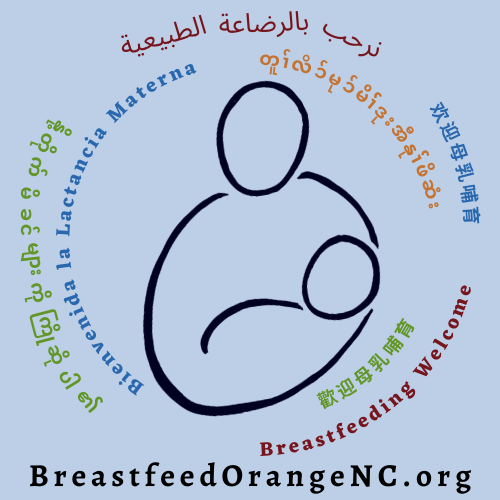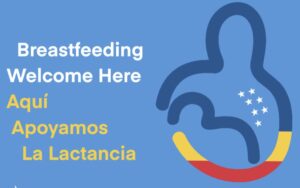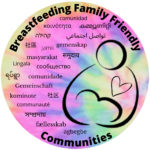As community advocates, we know that breastfeeding/chestfeeding and human milk feeding provides essential nutrients and immune factors to support optimal infant nutrition, growth, and development. Families need equitable access to unbiased support and resources; however, many families face challenges in initiating and continuing chestfeeding/breastfeeding, particularly in communities where access to support and resources is limited, commercially-driven, or unavailable to all families in the community.
The Ten Steps to a Breastfeeding Family Friendly Community (Ten Steps) provides a framework to address those challenges. Step 4 of the Ten Steps recognizes the importance of providing unbiased, culturally-appropriate education and resources about the benefits of chestfeeding/breastfeeding, as well as the risks associated with unnecessary formula use.
STEP 4. During pregnancy, all families in the community are informed about the benefits of chest/breastfeeding, as well as about the risks of unnecessary formula use, and where to access support as needed.
Ten Steps to a Breastfeeding Family Friendly Community
Breastfeed Durham and Breastfeed Orange NC have implemented a range of strategies to promote and support breastfeeding practices in their communities, such as the availability and distribution of educational materials, community outreach and engagement, virtual training for healthcare providers, and educational outreach events. These efforts have helped to increase access to information and support for families and healthcare providers, supporting the initiation and continuation of breastfeeding in the community.
We offer five ways in which each community has distributed materials on the benefits of chestfeeding/breastfeeding to address the requirements of Step 4. Some of the strategies were implemented in both communities with adaptations that reflected the uniqueness and energy of each community, and some strategies met the specific needs of the communities. To learn more about these and other strategies and ideas for using these strategies in your community, check out the page: Informing Families During Pregnancy.

Five strategies from Breastfeed Orange NC
- Educational materials: Breastfeed Orange created educational materials, including brochures and posters, which were distributed to healthcare providers, community organizations, and local businesses.
- Workshops: The initiative held informational sessions and workshops for healthcare providers and lactation consultants to ensure accurate and up-to-date information on breastfeeding was being shared with families.
- Social Media: Breastfeed Orange used social media and online platforms to share information and resources on breastfeeding, including a dedicated website and Facebook page.
- Stakeholder support: The initiative partnered with stakeholders to ensure consistent messaging and support for chestfeeding/breastfeeding families throughout Orange County.
- Collaboration: Breastfeed Orange worked closely with community organizations, such as WIC and the Partnership for Young Children, to reach families who may have limited access to breastfeeding resources and support.

Five strategies from Breastfeed Durham
- Social Media: Breastfeed Durham utilized social media platforms such as Facebook, Instagram, and Twitter to share educational materials, articles, and tips on the benefits of breastfeeding.
- Brochures and Flyers: Breastfeed Durham distributed brochures and flyers containing information on the benefits of breastfeeding to healthcare providers, community organizations, and individuals in Durham County.
- Website: Breastfeed Durham’s website contains a wealth of information on the benefits of breastfeeding, including frequently asked questions, local resources, and links to related research.
- Workshops and Presentations: Breastfeed Durham hosted workshops and presentations on the benefits of breastfeeding for healthcare providers, community organizations, and individuals in Durham County.
- Partnership: Breastfeed Durham partnered with trusted community advocates to distribute printed materials on the benefits of breastfeeding in Durham county. Train and incentivize local advocates who are well-known and respected in the community. Together, attend health fairs and visit local businesses to distribute printed materials about the benefits of breastfeeding. This partnership has allowed the Breastfeed Durham to build strong relationships with local businesses and health providers, as well as to increase awareness and support for breastfeeding in Durham county.
And so that you do not feel left out, here are some suggestions – “Five things that your community can do” – for you to consider trying in your community. These are only suggestions. We recognize that each community is different.
Five things that your community can do:
- Host community events and classes: Communities can organize community events and classes to educate families on the benefits of breastfeeding. These events can be held at local community centers, churches, or healthcare clinics and can be led by healthcare professionals, lactation consultants, or breastfeeding peer counselors.
- Partner with healthcare providers: Communities can partner with healthcare providers, such as pediatricians and obstetricians, to distribute information on the benefits of breastfeeding to families. Healthcare providers can provide information and resources to their patients during prenatal and postpartum visits.
- Use social media: Communities can use social media platforms, such as Facebook, Twitter, and Instagram, to share information and resources on the benefits of breastfeeding and the challenges to successful breastfeeding from unnecessary formula use. Social media can be a powerful tool to reach families in the community and can be used to share stories and experiences of chestfeeding/breastfeeding mothers.
- Create and distribute informational materials: Communities can create and distribute informational materials, such as brochures and flyers, to educate families on the benefits of breastfeeding. These materials can be distributed at community events, healthcare clinics, and local businesses.
- Train and support peer counselors: Communities can train and support breastfeeding peer counselors to provide education and support to families in the community. Peer counselors are trained to provide breastfeeding support and can help families overcome common breastfeeding challenges. They can also serve as a valuable resource for families seeking breastfeeding information and support.
We hope that these suggestions will inspire you in your work on Step 4. We encourage you to reach out to Breastfeeding Communities – contact@breastfeedingcommunities.org – with questions and ideas to share with other communities.
Resources
- Human Milk and Brain Development in Infants, Reproductive Medicine. 2021, 2(2), 107-117 (https://doi.org/10.3390/reprodmed2020011)
- The Surgeon General’s Call to Action to Support Breastfeeding (https://www.cdc.gov/breastfeeding/resources/calltoaction.htm)
- Ten Steps to a Breastfeeding Family Friendly Community Approaches and Measures

